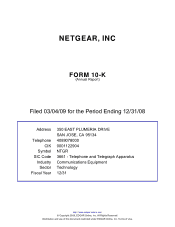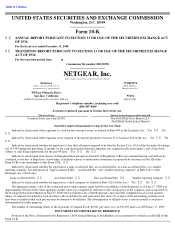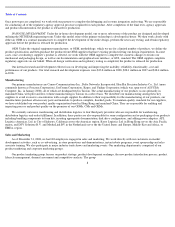Netgear 2008 Annual Report Download - page 9
Download and view the complete annual report
Please find page 9 of the 2008 Netgear annual report below. You can navigate through the pages in the report by either clicking on the pages listed below, or by using the keyword search tool below to find specific information within the annual report.
Table of Contents
2Wire, Inc. Our potential competitors include consumer electronics vendors and telecommunications equipment vendors who could integrate
networking capabilities into their line of products, and our channel customers who may decide to offer self-branded networking products. We
also face competition from service providers who may bundle a free networking device with their broadband service offering, which would
reduce our sales if we are not the supplier of choice to those service providers.
Many of our existing and potential competitors have longer operating histories, greater name recognition and substantially greater
financial, technical, sales, marketing and other resources. As a result, they may have more advanced technology, larger distribution channels,
stronger brand names, better customer service and access to more customers than we do. For example, Hewlett-Packard has significant brand
name recognition and has an advertising presence substantially greater than ours. Similarly, Cisco Systems is well recognized as a leader in
providing networking products to businesses and has substantially greater financial resources than we do. Several of our competitors, such as the
Linksys division of Cisco Systems and D-
Link, offer a range of products that directly compete with most of our product offerings. Several of our
other competitors primarily compete in a more limited manner. For example, Hewlett-Packard sells networking products primarily targeted at
larger businesses or enterprises. However, the competitive environment in which we operate changes rapidly. Other large companies with
significant resources could become direct competitors, either through acquiring a competitor or through internal efforts.
We believe that the principal competitive factors in the small business and home markets for networking products include product breadth,
size and scope of the sales channel, brand name, timeliness of new product introductions, product performance, features, functionality and
reliability, price, ease-of-installation, maintenance and use, and customer service and support.
To remain competitive, we believe we must invest significant resources in developing new products and enhancing our current products
while continuing to expand our sales channels and maintaining customer satisfaction worldwide.
Research and Development
As of December 31, 2008, we had 158 employees engaged in research and development. We believe that our success depends on our
ability to develop products that meet changing user needs and to anticipate and proactively respond to evolving technology in a timely and cost-
effective manner. Accordingly, we have made investments in our research and development department in order to effectively evaluate new third
party technologies, develop new in-house technologies, and develop and test new products. Our research and development employees work
closely with our technology and manufacturing partners to bring our products to market in a timely, high quality and cost-efficient manner.
We identify, qualify or self-develop new technologies, and we work closely with our various technology suppliers and manufacturing
partners to develop products using one or more of the development methodologies described below.
ODM. Under the original design manufacturer, or ODM, methodology, which we use for most of our product development activities, we
define the product concept and specification and perform the technology selection. We then coordinate with our technology suppliers while they
develop the chipsets, software and detailed circuit designs. On certain new products, one or more subsystems of the design can be done in-house
and then integrated in with the remaining design pieces from the ODM. Once prototypes are completed, we work with our partners to complete
the debugging and systems integration and testing. Our ODMs are responsible for conducting all of the regulatory agency approval processes
required for each product. After completion of the final tests, agency approvals and product documentation, the product is released for
production.
CM . Under the contract manufacturer, or CM, methodology, which we use for a limited number of products, we define the product
concept and specification and develop the primary technology and software internally.
7






















